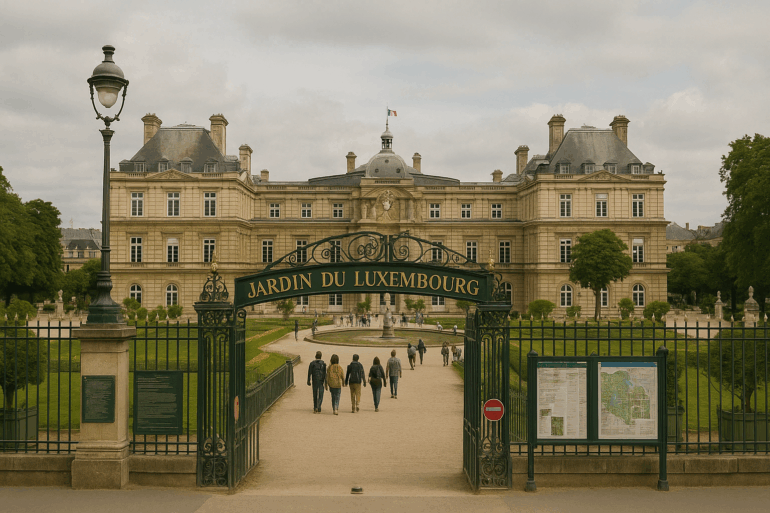Introduction to the Luxembourg Gardens
Located in the heart of the French capital, the Luxembourg Gardens are a true green gem that attracts millions of visitors each year. Whether you’re a nature lover, a history enthusiast, or simply looking for a peaceful place to relax, this iconic garden has something to offer everyone. I invite you to discover this enchanting place where natural beauty blends harmoniously with cultural heritage.
The Luxembourg Gardens are much more than just a green space. They serve as a sanctuary where one can escape the hustle and bustle of the city while staying close to Paris’s main attractions. This park brings history to life through its sculptures, fountains, and majestic paths. As you stroll through its winding walkways, you can’t help but feel a deep connection with the past.
Over the years, the park has evolved into a meeting and leisure place for Parisians and tourists from around the world. It is a must-visit destination for those who want to explore the soul of Paris, a city that elegantly combines tradition and modernity. Let’s dive into the history and beauty of this remarkable garden.
The Fascinating History of the Luxembourg Gardens
The Luxembourg Gardens have a rich and captivating history that dates back several centuries. Created in 1612 by Marie de’ Medici, the widow of King Henry IV, the park was originally designed as the garden of the Luxembourg Palace. Inspired by the Boboli Gardens in Florence, Marie de’ Medici wanted to recreate a space that reminded her of her native Italy.
Over the years, the garden underwent numerous transformations. In the 18th century, it was expanded and redesigned by architect Jean Chalgrin, who gave it its current layout. During the French Revolution, the garden was opened to the public, becoming a space accessible to all. This marked the beginning of a new era for the Luxembourg Gardens, solidifying its status as an iconic part of Parisian life.
Today, the garden is managed by the French Senate, which sits in the Luxembourg Palace. It continues to serve as a place of gathering, relaxation, and culture, attracting visitors from all walks of life. The history of the Luxembourg Gardens is a tribute to resilience and Paris’s ability to reinvent itself while preserving its heritage.
Architectural Features of the Gardens
The Luxembourg Gardens are an outstanding example of French landscape architecture, with their symmetrical walkways, beautifully maintained flowerbeds, and elegant statues. The center of the garden is dominated by a large octagonal basin, around which visitors can stroll or sit to enjoy the calm and beauty of the surroundings.
The garden is also adorned with numerous sculptures, many of which pay tribute to historical and literary French figures. Among them are statues of notable personalities such as George Sand, Charles Baudelaire, and Frédéric Chopin. These open-air artworks add a cultural dimension to the garden, turning each walk into a living history lesson.
Another remarkable architectural feature is the Medici Fountain, located at the northern end of the garden. Commissioned by Marie de’ Medici herself, this baroque masterpiece is surrounded by lush greenery, creating a tranquil oasis where one can escape the city’s noise. The Luxembourg Gardens are a testament to French architectural know-how and a celebration of timeless beauty.
Biodiversity and Flora in the Luxembourg Gardens
The Luxembourg Gardens are a true haven of biodiversity in the heart of Paris. With its expansive lawns, centuries-old trees, and colorful flowerbeds, the garden provides a precious refuge for a multitude of plant and animal species. The Luxembourg’s gardeners work tirelessly to preserve this natural wealth, ensuring the garden remains a thriving space year-round.
Visitors can admire a wide variety of plants, from fragrant roses to vibrant tulips, as well as rhododendrons and azaleas. Each season brings new colors and scents, transforming the garden into a living painting. The greenhouses also house an impressive collection of tropical and exotic plants, offering curious minds a glimpse into global botanical diversity.
In addition to its flora, the Luxembourg Gardens are home to many birds and small animals. Ducks and swans lounge in the large pond, while squirrels playfully scamper through the trees. This idyllic setting is the perfect place to reconnect with nature, far from the stress of urban life. A visit to the Luxembourg Gardens reveals not only the beauty of nature, but also the importance of preserving it for future generations.
Activities to Enjoy in the Luxembourg Gardens
The Luxembourg Gardens offer far more than just scenic walks. They provide a wide range of activities for both children and adults, making each visit a unique experience. Whether you’re looking for relaxation or adventure, you’ll find something to enjoy in this exceptional park.
For sports enthusiasts, the garden offers several facilities, including tennis courts and jogging paths. These spaces allow visitors to maintain a fitness routine while enjoying fresh air and picturesque surroundings. Additionally, the park regularly hosts yoga and tai chi classes—perfect opportunities to recharge and find inner balance.
Families are also well catered for, with activities specifically designed for children. A puppet theatre, merry-go-rounds, and swings provide unforgettable moments of joy for the little ones. Meanwhile, adults can unwind on the many chairs and benches scattered throughout the park, taking in the view and peaceful atmosphere.
Cultural and Artistic Events in the Gardens
The Luxembourg Gardens are also a prominent cultural and artistic hub. Throughout the year, the park hosts a variety of events that enrich the cultural life of Paris. From open-air concerts and art exhibitions to readings and conferences, it is a dynamic space where creativity flourishes.
Among the most popular events are the classical music concerts held at the park’s bandstand. These free performances attract music lovers from all backgrounds, offering a unique auditory experience in a charming setting. Temporary art exhibitions also take place in the garden, giving visitors a chance to discover works by both contemporary and classical artists.
Literature lovers will enjoy the public readings and discussions that are regularly organized in the park. These events offer a rare opportunity to meet influential authors and thinkers, deepening our understanding of the world through words. The Luxembourg Gardens are a place where art and culture converge, inspiring all who visit.
Practical Tips for Visiting the Luxembourg Gardens
To make the most of your visit to the Luxembourg Gardens, a few practical tips may come in handy. First, consider timing your visit according to the seasons. Each time of year offers a different experience, with unique blooms and events. Spring is especially loved for its flowers, while summer is ideal for open-air concerts.
Next, make sure to explore all areas of the garden. The park is vast, and each corner has its own charm. Don’t miss the Medici Fountain, the Davioud Pavilion, and the rose garden—some of the highlights of the grounds. Also take time to relax near the large basin, where you can watch children sail little wooden boats.
Finally, consider bringing something to eat. The garden has several kiosks and cafés where you can enjoy French treats with a view. Alternatively, you can bring a picnic and settle on one of the many lawns. The Luxembourg Gardens are a place to unwind and savor life’s simple pleasures.
The Importance of the Luxembourg Gardens in Parisian Life
The Luxembourg Gardens hold a special place in the hearts of Parisians. This park is more than a place to relax—it is a symbol of the city’s cultural identity. For centuries, it has played a central role in Paris’s social and cultural life, offering a space where people can gather, exchange ideas, and rejuvenate.
For locals, the garden is a favorite meeting place. People come to stroll, read, chat, or simply breathe in the fresh air. It’s a space where generations mingle—children play while adults engage in more tranquil activities. The Luxembourg Gardens embody the spirit of conviviality and sharing that characterizes Paris so well.
Moreover, the garden is a key player in promoting culture and art. It hosts events that attract visitors from around the world, contributing to Paris’s international reputation as an artistic and cultural capital. The Luxembourg Gardens are where tradition meets modernity, enriching Parisian life and inspiring all who pass through.
How to Get to the Luxembourg Gardens
The Luxembourg Gardens are easy to access, whether you’re a resident or a tourist. Located in the 6th arrondissement, the park is well served by public transport. You can take the metro via line 4 (Odéon station) or line 10 (Mabillon station). Bus lines 21, 27, 38, 82, 84, and 89 also stop nearby, offering a variety of travel options.
If you prefer to walk, the garden is just steps away from iconic neighborhoods like Saint-Germain-des-Prés and the Latin Quarter. A stroll through these districts will let you discover the authentic charm of Paris before reaching the serenity of the garden. For those arriving by car, several parking lots are available nearby, although parking may be limited during peak seasons.
For international visitors, the Luxembourg Gardens are also easily accessible from Paris’s main train stations. Whether arriving at Gare du Nord, Gare de Lyon, or Gare Montparnasse, a short metro or taxi ride will take you directly to the park. Getting to the Luxembourg Gardens is simple and fast, making it a perfect destination for anyone looking to explore Paris.
Conclusion: A Must-See Destination in Paris
The Luxembourg Gardens are undoubtedly one of the most iconic places in Paris. With their rich history, natural beauty, and wide range of activities, they offer an unforgettable experience to all who visit. Whether you’re a regular or a first-time visitor, the garden invites you to discover the very essence of Paris—a city where art, culture, and nature come together in harmony.
By visiting the Luxembourg Gardens, you do more than explore a green space—you immerse yourself in the history and soul of the French capital. This park is a silent witness to the passage of time, a place where memories are made and shared. It is a constant reminder of the beauty and cultural richness of Paris, a treasure to be preserved for future generations.





